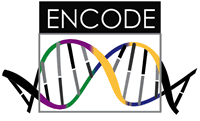Last updated: April 08, 2015
ENCODE/Roadmap Epigenomics Tutorial - October 2014, ASHG
ENCODE/Roadmap Epigenomics Tutorial - October 2014, ASHG
 On October 18, 2014, the ENCODE consortium held a workshop at the American Society of Human Genetics (ASHG) annual meeting.
On October 18, 2014, the ENCODE consortium held a workshop at the American Society of Human Genetics (ASHG) annual meeting.
This introductory workshop was intended for a diverse audience. We introduced the curated metadata that describe the ENCODE, modENCODE and Roadmap Epigenomics datasets.
We introduced web-based tools for accessing these resources.
Workshop attendees received hands-on experience using the following resources to:
- Search for datasets using the new ENCODE portal [encodeproject.org]
- Visualize selected data on a browser such as the ENSEMBL browser or UCSC Genome Browser
- Annotate non-coding variants based on integrated analyses of these datasets
- Generate hypotheses about the regulation of a gene of interest or regulatory impact of a non-coding variant using ENCODE data.
This workshop educated researchers, clinicians, and genetic counselors on how to use ENCODE data to generate hypotheses for further biological investigation.
Agenda and Resources
All files are in ![]() format.
format.
ENCODE Introduction and Overview of the Consortium
Eurie L. Hong, Stanford University
Presentation: ENCODE Introduction
Using the ENCODE Portal (Hands-On)
Seth Strattan, Stanford University
Presentation: Using the ENCODE Portal
Genome Annotations
Mark Gerstein, Yale University
Presentation: Genome Annotations
How to Interpret and Read a Track (Hands-On)
Richard Sandstrom, University of Washington
There are no slides for this live demonstration. Some similar topics were recently addressed here:
- Viewing ENCODE data tracks on the UCSC browser [genome.ucsc.edu]
- Using the UCSC table browser [openhelix.com]
Variant Annotation Using ENCODE Data (Hands-On)
Luke Ward, Massachusetts Institute of Technology
There are no slides for this live demonstration. Some similar topics were recently addressed here:
- Using HaploReg and RegulomeDB to interpret non-coding variants
- Using the Regulatory Elements Database to predict connectivity between candidate regulatory elements and target genes
- Using the Regulatory Elements Database to predict connectivity between a gene of interest and candidate regulatory elements
For questions or more information contact:
Michael Pazin, Ph.D.
E-mail: pazinm@mail.nih.gov
To view the PDF document(s) on this page, you will need Adobe Reader. ![]()
Posted: April 8, 2015
